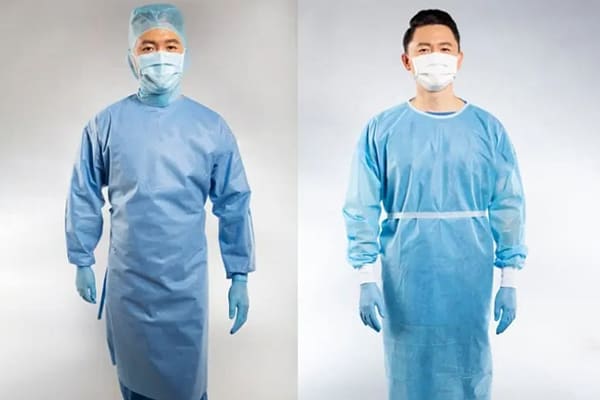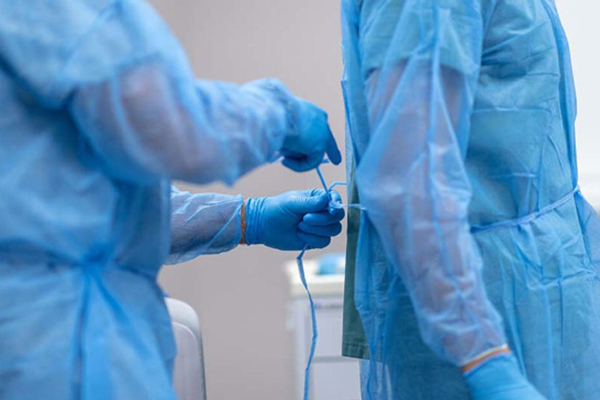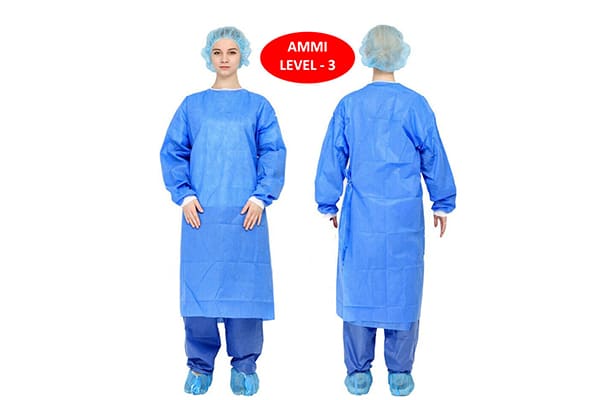In the world of healthcare, ensuring the safety of both patients and medical staff is paramount. This article dives deep into the critical role of AAMI Level 3 surgical gowns, a cornerstone of infection control in operating rooms and beyond. We’ll break down what these medical gowns are, why they are important, and how they contribute to a safer healthcare environment. If you’re involved in healthcare procurement, or simply want to understand the layers of protection in medical settings, this article is for you. We’ll simplify the jargon and provide clear, actionable information about these essential pieces of personal protective equipment (PPE).
1. What are Medical Gowns and Surgical Gowns? Understanding the Basics
In any healthcare setting, especially within a busy hospital or clinic, you’ll see medical professionals wearing various types of gowns. But what exactly are medical gowns and surgical gowns, and what differentiates them? Essentially, both are types of protective apparel used in healthcare facilities to create a barrier between the wearer and potential contaminants. Think of them as a shield, protecting both healthcare workers and patients from the spread of infection or illness.

Medical gowns encompass a broad category. They are gowns intended for a range of healthcare activities, from routine patient exams to caring for patients with potentially infectious conditions. These gowns are designed to protect the wearer’s apparel from splashes and spills of body fluids. You might see a nurse wearing a medical gown while administering medication or a doctor using one during a non-invasive examination.
Surgical gowns, on the other hand, are specifically designed for use during surgical procedures in the operating room. They are a critical component of maintaining a sterile field. These gowns must provide a higher level of barrier protection, particularly in the critical zones – the areas most likely to come into contact with blood and other body fluids. Surgical gowns are often longer and made of materials that offer superior fluid resistance compared to standard medical gowns. The key distinction lies in the level of barrier protection required, with surgical gowns offering a more robust defense for more demanding, invasive procedures. Think of a surgeon needing maximum protection during a complex operation – that’s where a high-quality surgical gown becomes indispensable.
2. Decoding AAMI Levels for Medical Gowns: What Do They Mean?
To ensure consistency and clarity in barrier protection, organizations like the Association for the Advancement of Medical Instrumentation (AAMI) have established standardized classifications for medical gowns. These AAMI levels, ranging from Level 1 to Level 4, provide a clear and universally understood system for evaluating and selecting gowns based on their liquid barrier performance and classification. Understanding these levels is crucial for healthcare procurement managers like Mark Thompson to choose the right gown for the right procedure.
The AAMI classification system focuses on the gown’s ability to resist fluid penetration. Each level corresponds to a specific level of barrier protection against fluid and microbial contaminants. Level 1 gowns offer the lowest level of protection, suitable for minimal risk situations like basic care in a standard medical unit. As the level number increases, so does the level of protection. Level 2 gowns provide greater fluid barrier protection than Level 1, and so on. This tiered system allows healthcare facilities to select gowns that are appropriate for the anticipated level of fluid exposure during different medical procedures.

Think of it like this: you wouldn’t wear a raincoat designed for a light drizzle in a torrential downpour. Similarly, in healthcare, you need different levels of barrier protection depending on the procedure. AAMI levels provide that guidance, ensuring that healthcare professionals are equipped with gowns that offer the necessary protection level for their specific tasks. This standardized system is a cornerstone of infection control, simplifying the selection process and promoting patient and staff safety.
3. Focus on AAMI Level 3: What Makes These Surgical Gowns Special?
Now, let’s zoom in on AAMI Level 3 surgical gowns. These gowns represent a significant step up in barrier protection compared to Level 1 and Level 2 options. Level 3 gowns are designed for procedures with a moderate risk of fluid exposure. They offer a substantial barrier against fluid penetration, making them suitable for a wider range of surgical procedures and healthcare activities.
What distinguishes Level 3 gowns? Primarily, it’s their enhanced liquid barrier performance. They are constructed from materials that can withstand moderate fluid pressure and provide a reliable barrier against fluid strike-through. This is crucial in surgical procedures where splashes and sprays of blood or irrigation fluids are possible. Level 3 gowns typically have reinforced critical zones, providing extra barrier protection in areas like the chest and sleeves, where exposure is most likely.
Compared to Level 4 gowns, which offer the highest fluid and microbial barrier, Level 3 gowns strike a balance. They provide robust protection without the heavier materials and potentially higher cost associated with Level 4. For many surgical procedures and situations in intensive care unit settings where moderate fluid barrier protection is required, Level 3 gowns offer an optimal solution. They are a workhorse in the world of surgical gowns, providing a strong defense against infection risks in a variety of healthcare scenarios.
4. When is AAMI Level 3 Protection the Right Choice? Identifying Appropriate Use Cases
Knowing when to use an AAMI Level 3 surgical gown is essential for effective infection control and cost-efficient procurement. These gowns are the go-to choice for a range of medical procedures and situations where moderate fluid exposure is anticipated. They offer a balance of protection and practicality, making them a versatile option in many healthcare settings.
Level 3 gowns are commonly used in surgical procedures that are considered minimally invasive surgical procedures or involve a moderate amount of fluid. Think of procedures like appendectomies, gall bladder removals, or cesarean sections. In these scenarios, while there is a risk of fluid exposure, it’s generally less extensive than in high-risk, complex surgeries requiring Level 4 protection. Level 3 gowns provide adequate barrier protection to keep the surgical team safe from bloodborne pathogens and other contaminants.

Beyond the operating room, Level 3 gowns are also appropriate in other areas of the hospital. For example, they are often used in intensive care units (ICUs) when performing procedures like arterial blood draw or inserting an intravenous line, where there’s a risk of blood splashes. They can also be used in emergency departments or during wound care procedures where moderate fluid exposure is expected. In situations where infectious diseases are suspected, and moderate pathogen resistance is needed, Level 3 gowns can provide an appropriate level of barrier protection for healthcare workers. Choosing Level 3 gowns for these scenarios ensures staff safety without overspending on Level 4 gowns when they aren’t strictly necessary.
5. Key Features and Construction of Level 3 Surgical Gowns: What to Look For?
When procuring AAMI Level 3 surgical gowns, understanding their key features and construction is vital to ensure you’re selecting a product that delivers the promised barrier protection. These gowns are engineered with specific design elements and materials to meet the Level 3 performance standards.
Material is a primary factor. Level 3 gowns are typically made from multi-layer materials, often combining spunbond and meltblown polypropylene. This combination provides both strength and fluid resistance. The outer layers often offer fluid repellency, while inner layers act as a barrier to prevent fluid penetration. Seam construction is also critical. Seams in Level 3 gowns are often reinforced to prevent fluid leakage, particularly in critical zones. Look for gowns with sonically welded or taped seams for enhanced barrier protection.
Design features contribute to overall protection and functionality. Level 3 gowns typically have long sleeves with elastic or knit cuffs to provide a secure closure at the wrists, preventing contaminants from entering. The entire gown should provide adequate coverage, typically extending below the knees to protect a significant portion of the body. Many Level 3 gowns are also designed with ties at the neck and waist to ensure a secure and adjustable fit. When evaluating Level 3 surgical gowns, pay close attention to the materials, seam construction, and design features to ensure they meet the necessary barrier protection requirements and provide healthcare professionals with the confidence they need in demanding medical environments.
6. The Importance of Barrier Protection: Fluid Resistance and Microbial Defense
The core function of AAMI Level 3 surgical gowns is to provide robust barrier protection. This barrier is crucial in preventing the transmission of pathogens and ensuring the safety of both healthcare workers and patients. Barrier protection in surgical gowns primarily encompasses two key aspects: fluid resistance and microbial defense.
Fluid resistance is the ability of the gown material to prevent fluid penetration. In surgical procedures and other medical settings, healthcare workers are potentially exposed to various body fluids, including blood, irrigation fluids, and other secretions. Level 3 gowns are engineered to withstand moderate fluid pressure and prevent these fluids from soaking through to the wearer’s skin or clothing. This is especially important in protecting against bloodborne pathogens like hepatitis B virus (HBV), hepatitis C virus (HCV), and human immunodeficiency virus (HIV). The liquid barrier performance and classification of Level 3 gowns ensures they meet specific standards for fluid resistance, giving healthcare professionals confidence in their protection.
Microbial defense is another critical aspect of barrier protection. Surgical gowns must prevent the passage of microorganisms, such as bacteria and viruses, in both directions – protecting the patient from contamination by the healthcare worker and vice versa. Level 3 gowns, with their multi-layer construction and reinforced seams, provide an effective barrier against microbial penetration. This is vital in maintaining a sterile field in the operating room and reducing the risk of surgical site infections. By effectively combining fluid resistance and microbial defense, Level 3 surgical gowns play a central role in infection prevention and control in healthcare settings.
7. Beyond the Gown: Complementary Protective Apparel and Surgical Drapes
While surgical gowns are a cornerstone of protective apparel in the operating room, they are often used in conjunction with other medical devices and drapes to create a comprehensive barrier system. Surgical drapes are essential components of this system, working alongside gowns to minimize the risk of infection and maintain a sterile surgical field.
Surgical drapes are designed to cover the area surrounding the surgical site, creating a sterile barrier between the patient and the operating room environment. They prevent microorganisms from migrating into the surgical site from non-sterile areas. Drapes intended for use with surgical gowns come in various sizes and configurations, including fenestrated drapes with openings for the surgical site and non-fenestrated drapes for general coverage. Like surgical gowns, surgical drapes are also classified based on AAMI levels of barrier protection. Using surgical gowns and drapes together creates a more robust barrier than using either alone.
In addition to drapes, other protective apparel may be used with surgical gowns, depending on the procedure and the level of risk. This can include medical bouffant caps to cover hair, medical shoe covers to prevent contamination from footwear, and medical face masks to protect against respiratory droplets. These items, along with surgical gowns and drapes, are all gowns are examples of personal protective equipment (PPE), working synergistically to create a multi-layered defense against infection in the operating room and other critical healthcare areas. Thinking holistically about protective apparel and drapes intended for use together is key to maximizing infection control effectiveness.
8. Quality and Compliance: FDA Regulations and Medical Device Standards for Gowns
For healthcare procurement professionals like Mark Thompson, quality and regulatory compliance are paramount when selecting surgical gowns. Medical gowns, including surgical gowns, are considered medical devices and are subject to stringent regulations by agencies like the Food and Drug Administration (FDA) in the USA. Understanding these regulations is crucial to ensure that purchased gowns meet the necessary safety and performance standards.
In the USA, surgical gowns are class i devices exempt from premarket notification 510(k), while surgical isolation gowns are used when there is a moderate to high risk of contamination and are considered fda as a class ii medical device that requires premarket notification 510(k). This means that manufacturers of surgical isolation gowns must demonstrate to the FDA that their gowns are substantially equivalent to legally marketed predicate devices and meet specific performance requirements. These requirements often reference american national standards developed by organizations like AAMI.
AAMI standards, such as ANSI/AAMI PB70, are widely recognized and used to evaluate the performance and classification of protective apparel, including surgical gowns. This standard outlines the liquid barrier performance and classification levels (Level 1 to Level 4) and the testing methods used to assess gown performance. Compliance with these standards and FDA regulations ensures that surgical gowns provide the promised level of protection and are safe for use in health care settings. When sourcing medical gowns, always look for manufacturers who can demonstrate compliance with relevant standards and regulations, including ISO 13485 for quality management systems and certifications like CE marking for European markets.
9. Choosing the Right Level 3 Surgical Gown Supplier: Key Considerations for Procurement
Selecting a reliable supplier for AAMI Level 3 surgical gowns is a critical decision for healthcare facilities. The quality of the gown directly impacts patient and staff safety, so careful consideration is needed. For procurement managers like Mark Thompson, several key factors should guide the selection process.
First and foremost, verify the supplier’s certifications and compliance with relevant standards. Do they have ISO 13485 certification? Can they provide evidence of FDA registration or CE marking? Do their Level 3 gowns meet the ANSI/AAMI PB70 standard? These certifications demonstrate a commitment to quality and regulatory compliance. Secondly, assess the supplier’s manufacturing capabilities and quality control processes. A factory with modern production lines and robust quality checks is more likely to consistently produce high-quality gowns. As a factory with 7 production lines in China, we at ZhongXing prioritize quality and compliance in every step of our manufacturing process.
Consider the supplier’s experience in the disposable medical consumables industry, particularly with surgical gowns. A supplier with a proven track record and experience in exporting to countries like the USA, Europe, and Australia is likely to be more reliable and understand the specific requirements of these markets. Finally, evaluate the supplier’s pricing, lead times, and customer service. Competitive pricing is important, but it should not come at the expense of quality. Reliable lead times and responsive customer service are crucial for ensuring a smooth and dependable supply chain. By carefully evaluating these factors, healthcare facilities can choose a surgical gown supplier that meets their quality, compliance, and logistical needs.
10. Ensuring Proper Use and Disposal of Level 3 Gowns: Best Practices for Healthcare Facilities
Even the highest quality AAMI Level 3 surgical gown will only be effective if used and disposed of correctly. Healthcare facilities must implement clear protocols and training programs to ensure proper gowning and de-gowning procedures, as well as safe disposal practices. Proper use is just as important as choosing the right gown.
Gowning should be performed in a designated clean area, following a step-by-step procedure. This typically involves hand hygiene before donning the gown, ensuring the gown is correctly positioned and tied securely, and putting on other PPE like gloves and masks. De-gowning is even more critical, as it’s the point where contamination is most likely to occur. The de-gowning process should be performed in a designated area, often just outside the patient care area, and must be done carefully to avoid self-contamination. Protocols usually involve removing gloves first, followed by the gown, taking care to roll it inwards to contain contamination, and then performing hand hygiene again.
Disposal of disposable surgical gowns must be handled as medical waste according to local regulations. Used gowns should be placed in designated waste containers, typically lined with biohazard bags. Healthcare staff must be trained on these procedures and regularly reminded of their importance. Regular audits and competency checks can help ensure that gowning and de-gowning protocols are consistently followed. By emphasizing proper use and disposal, healthcare facilities can maximize the effectiveness of Level 3 gowns and further reduce the risk of infection transmission, creating a safer environment for everyone.
Key Takeaways: AAMI Level 3 Surgical Gowns
- AAMI Level 3 surgical gowns offer moderate barrier protection against fluid penetration, suitable for a wide range of surgical procedures and healthcare activities.
- Level 3 gowns are essential protective apparel for procedures with a moderate risk of fluid exposure, striking a balance between protection and practicality.
- Key features include multi-layer materials, reinforced seams, and design elements like long sleeves with cuffs for enhanced barrier protection.
- Barrier protection encompasses both fluid resistance and microbial defense, crucial for preventing pathogen transmission.
- Surgical drapes and other PPE complement surgical gowns to create a comprehensive infection control system.
- FDA regulations and AAMI standards ensure the quality and liquid barrier performance and classification of medical gowns.
- Choosing a reliable supplier with proper certifications and quality manufacturing processes is vital.
- Proper gowning, de-gowning, and disposal procedures are essential for maximizing the effectiveness of Level 3 gowns.
By understanding the nuances of AAMI Level 3 surgical gowns, healthcare professionals and procurement managers can make informed decisions, contributing to safer and more effective healthcare delivery. Remember, choosing the right gown is choosing to prioritize safety and well-being in every medical setting. For high-quality medical gauze bandage roll and reliable medical bed sheet options, explore our product range. We also offer a variety of disposable medical face mask solutions to meet your facility’s needs. And for complete surgical setups, consider our sterile surgical suture with needle products. We are committed to providing dependable medical consumables for a safer healthcare world.
Post time: 2月-10-2025





